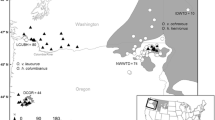Abstract
Captive-reproduced stocks of some species of ungulates (Artiodactyla), and particularly the red deer (Cervus elaphus), fallow deer (Dama dama), roe deer (Capreolus capreolus) and the wildboar (Sus scrofa) are more or less extensively translocated in Italy, mainly for local reintroductions or restocking of exploited wild populations. However, captive breeding often involves the reproduction of non-indigenous individuals or the production of artificial hybrids. Consequently, translocations of captive-reproduced ungulates are of concern for the conservation of indigenous populations and gene pools. The impact of translocations should be evaluated within the background of the growing knowledge on population genetic and phylogeographic structure of ungulates. Molecular genetic markers are being used to map geographic genetic diversity, and reconstruct the phylogeographic history of natural populations (i.e., in the roe deer). Molecular makers are also used to detect the consequences of domestication and identify hybrids between wild and domesticated populations (i.e., in the wildboar), or to detect inter-specific hybridisation (i.e., between the red deer and wapiti). Hybridisation of wild and domestic pigs, and diffusion of hybrids in nature is widespread in Italy. Admixture of indigenous and non-indigenous roe deer stocks is also widespread. Therefore, conservation and management of indigenous ungulates calls for careful evaluation of captive-reproduced stocks.
Similar content being viewed by others
References
Avise, J.C. and Hamrick, J.L., 1996.Conservation Genetics(Chapman & Hall, New York)
Giuffra, E., Kijas, J.M.H., Amarger, R.V., Carlborg, O., Jeon, J.-T. and Andersson, L., 2000. The origin of the domestic pig: Independent domestication and subsequent introgression.Genetics, 154, 1785–1791
Montanaro, P., De Marinis, A.M., Riga, F., Focardi, S. and Toso, S., 2003. Variabilità craniometrica in alcune popolazioni italiane di Capriolo. In: C. Prigioni, A. Meriggi and E. Merli (eds), Atti IV Congresso Italiano di Teriologia, Riccione 6–8 november 2003.Hystrix, 14, 169–170
Oliver, W.L.R. (ed.), 1993.Pigs, Peccaries, and Hippos. Status Survey and Conservation Action Plan(ed WLR Oliver), IUCN/SSC Pigs and Peccaries Specialist Group, IUCN/SSC Hippo Specialist Group. IUCN, Gland, Switzerland, p. 202
Randi, E., 1995. Conservation genetics of the genus.Sus.Ibex, 3, 6–12
Randi, E., Lucchini, V. and Diong, C.H., 1996. Evolutionary genetics of the Suiformes as reconstructed using mtDNA sequencing.Journal of Mammalian Evolution, 3, 163–194
Randi, E., Pierpaoli, M. and Danilkin, A., 1998. Mitochondrial DNA polymorphism in populations of Siberian and European roe deer (Capreolus pygargusandC. capreolus).Heredity, 80, 429–437
Randi, E., Alves, P.C., Carranza, J., Milošević-Zlatanović, S., Sfougaris, A. and Mucci, N., 2004. Phylogeography of roe deer (Capreolus capreolus) populations. The effects of historical genetic subdivisions and recent non-equilibrium dynamics:Molecular Ecology, 13, 3071–3083
Spagnesi, M. and De Marinis, A.M. (a cura di), 2002.Mammiferi d'Italia. Quaderni di Conservazione della Natura, n. 14, Ministero dell'Ambiente, Istituto Nazionale per la Fauna Selvatica, Bologna
Tabarroni, C., Lucchini, V. and Randi, E., (in preperation). A deeply divergent mitochondrial DNA clade with geographic distribution restricted to Italian wild boars (Sus scrofa)
Author information
Authors and Affiliations
Corresponding author
Rights and permissions
About this article
Cite this article
Randi, E. Management of Wild Ungulate Populations in Italy: Captive-Breeding, Hybridisation and Genetic Consequences of Translocations. Vet Res Commun 29 (Suppl 2), 71–75 (2005). https://doi.org/10.1007/s11259-005-0025-1
Published:
Issue Date:
DOI: https://doi.org/10.1007/s11259-005-0025-1




